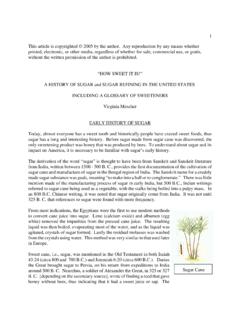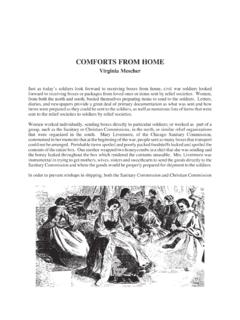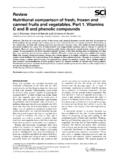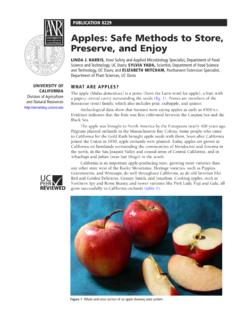Transcription of IN A PICKLE! - Ragged Soldier
1 in a pickle ! TYPES OF FOOD PRESERVATION IN THE 19TH CENTURY. Virginia Mescher [Author's Note: This article is only meant to offer an overview of food preservation methods used in the nineteenth century. A more comprehensive explanation of these methods will be found in the upcoming book, Well Preserved: The Story of Food Preservation and Storage in the Nineteenth Century. The book will contain more details for each preservation method and include documented recipes for each process. Stay tuned for the publication date.]. Before the age of commercial canning, freezing, refrigeration and freeze drying foods, food preservation was important to early man. They developed convenient ways to preserve fresh foods so that in the lean months they would have a relative constant food supply. In the beginning, drying , smoking, salting, fermentation, cold and potting were used. In later years, preservation using sugar, vinegar and alcohol were employed as preservatives.
2 In 1809, the age of modern canning techniques dawned. FOOD PRESERVATION BEFORE HEAT PROCESSING. An excellent period explanation of current food preservation appeared in the June, 1854 issue of Godey's. The article begins with, THE various organic substances furnished by the animal and vegetable king- doms, which constitute the food of man, are, from the nature of their chemical structure, liable to change and decay; they are also irregular in their supply; hence arises the necessity of storing up the abundance of one season to meet the deficiencies of another. The art of preserving food as much as possible in its original state is therefore of great importance; it has been improved by gradual steps, depending, in great measure, as in so many other cases, on chemical discovery and the diffusion of chemical knowledge among persons engaged in the useful arts; so that, at the present time, the deprivations suffered by our forefathers may be prevented; the commonest articles of food may be enjoyed at all seasons; and even the delicious fruits of our gardens may be made to contribute to our health and refreshment at a season when the trees which produced them are covered with snow.
3 The mariner, too, is not now necessarily confined to salt meats; he may, on the longest voyage, and in the severest clime, as easily enjoy fresh meat and vegetables as when he is in port. The article described various ways to preserve meats, vegetables and fruit. PRESERVATION OF ANIMAL PRODUCTS. AIR AND HEAT drying . drying was one of the first methods used to preserve meats and fish. The flesh was exposed to heat of not more than 140 because at any higher temperature, the protein fibers hardened to a point that it could not be hydrated. The American Indians used dried bison and deer, mixed with dried berries and marrow, to prepare pemmican. In the West Indies and in South America jerked meat was a variation of drying . The thinly sliced meat was dipped in sea-water or brine and then was dried in the sun. Occasionally, the dried meat was pounded into a paste and then packed into jars. In Brazil, the meat was sometimes mixed with cornmeal and packed into leather bags, which were used by travelers.
4 Although air drying was a method of preser- vation, there were very few instructions, in American period cook books, for preserving meat in this manner. Fish were dressed, slit down the middle and air dried. Smaller cod, haddock and other small fish could be preserved in this manner but salting was a more common method of preservation. PRESERVATION BY COLD. People in cold regions have long recognized the usefulness of cold storage or freezing. Residents of the colder areas of Russia, Hudson Bay in Canada and other cold regions had long used freezing to preserve foods. It was noted that caution, was needed, in thawing the frozen meat. If the meat was thawed too quickly, it would spoil and freshly thawed meat had to be cooked immediately. It was suggested that the meat be thawed in cold water to prevent spoilage. In addition to freezing to preserve foods for a longer period, ice was used to prevent the spoilage for a short period of time. Ice houses or ice-safes [refrigerators] were used for this purpose.
5 Spring houses were also used to keep items cold in order to lengthen their shelf life. SALTING. Sodium chloride, saltpetre, sal prunella (crystalline form of saltpetre) were all used in the salting of meat, of which there were two methods; dry salting and wet salting (corning, pickling or brining). With dry salting meat was packed in dry salt and or rubbed with a coating of salt but this method did not preserve the meat as long as wet salting. With wet salting, the meat was first rubbed with salt and salt was put between the layers of meat; then a brine was poured over the packed salted meat and was kept submerged in a brine solution. Pickling does not leave the meat as salty as in dry salting but it still needs to be pre- soaked, which removed excess salt, before cooking. Barreled salt pork is an example of pickling and there were varying grades of salt pork and the specified fat content and cuts of meat determined the grade of salt pork. Salt beef was prepared in much the same way.
6 Fish could also be dry or wet salted. Herring, cod, salmon, mackerel, sardines and anchovies were very familiar to nineteenth century consumers but were usually commercially processed rather than being done at home. In some cases, drying was employed with salting. The fish was salted salted for several days, then dried and for shipping, they were packed in boxes or barrels. Some fish were brined and then shipped in barrels, similar to the barrels of salt pork and beef. Usually fish was commercially preserved rather than being done at home. SMOKING or SMOKE drying . The process of curing often combined dry salting (sometimes with the addition of sugar and or spices). and smoking. Bacon, hams, some sausages and fish, such as salmon and herring were smoked. Heat from the smoke gave particular characteristics to the meat as well as a distinctive flavor. Cold smoking (smoked at a temperature of less than 85 F.) was sometimes used. It produced a mild smoke flavor but the meat or fish was not cooked and did not keep as long.
7 Hot smoking (smoked at a temperature of over 130 ) was the preferred method. The meat was partially cooked and the flesh developed a hardened surface, turned a brown or reddish brown color and had a stronger smoke flavor. The meat was partially cooked, it lasted longer. VINEGAR. Vinegar was used occasionally for preserving meat but it was more suited for preserving vegetables. One meat that did use vinegar as a preservative was souse or head cheese. It was made from the scraps of pork, such as the feet, ears, noses, and heads. Also, recipes for pickled oysters and herring appeared in cookbooks. Other fish, such as cockles, mussels, and salmon preserved in vinegar were popular in some parts of the world. ALCOHOL AND SUGAR. Most of us do not associate alcohol with meat preservation but it was a fairly common method of preserv- ing meat. Mincemeat, a mixture of chopped meat, raisins, currants, spices and brandy, was used in pies as tarts, just as it is used today.
8 The modern version of mincemeat is much sweeter and has much less meat in the mixture. CONCENTRATED FOODS. The process to make portable soup was a variation of concentrating and drying . As lean meat was boiled, the gelatine [sic] dissolved and the water evaporated, leaving a thick gelatinous substance which was cut into chunks and dried. The soup was reconstituted and was used by travelers or as a convenience food, much like bouillon cubes are used today. Concentrated meats were called meat biscuits and were introduced at England's Great Exhibition in 1851. Gail Borden started manufacturing meat biscuits but abandoned that enterprise when it did not meat with success so he then turned to milk preservation. POTTING. Potting of meat was a way to exclude the air from food which prevented oxidation and spoilage. Lean meat was cooked and either ground or chopped finely, and then it was made into a paste using a mortar. Salt and spices were added to the paste.
9 Then the spiced meat paste was tightly packed in jars and then covered with a thick layer of melted butter or lard. Modern examples of potted meat are the Underwood deviled meat spreads but since they are processed, the layer of fat is not needed. vegetable AND FRUIT PRESERVATION. Some of the methods used to preserve animal products were be used to preserve vegetables and fruit. The most common methods used for the preservation of vegetative matter were drying , sugar, vinegar, salt or alcohol and a hot water bath. AIR AND HEAT drying . Many kinds of vegetable and fruits may be dried. Beans were dried on the vine, then shelled and spread out to be completely dried. Small fruits were spread on the floor of a gently heated oven, in a warm dry place or placed in the sun and allowed to dry naturally. Often the larger fruits or vegetables, such as apricots, apples, peaches, plums, figs, pears, and pumpkins, were sliced before drying so that they would dry more evenly and quickly.
10 Sometimes the slices would be strung on fine string, hung from beams and allowed to dry in that manner. Other fruits were left whole, such as grapes, currants, cherries, and etc. and then dried. Nuts and herbs were also air dried. After being thoroughly dried, the items were placed in paper, dry boxes or put up in wooden casks. Another method of drying was to make a fruit leather or dry jam. Extremely ripe fruit was mashed and then was spread on plates to dry in a cooling oven or in the sun. When dry they were stored in paper bags and small pieces were cut off and soaked overnight in water when needed. The advantage of this method of preservation was that sugar was not needed to preserve the fruit because only very ripe fruit. Peaches, apples, cherries, and plums could be preserved in this manner. If the fruit was dried in a thicker layer, it was called a fruit biscuit. SALTING. Vegetables, such as French beans, artichokes, olives, samphire, barberries, red peppers, turnips, cauli- flower, beets, carrots and in some areas, kidney beans, could be preserved by salting.









